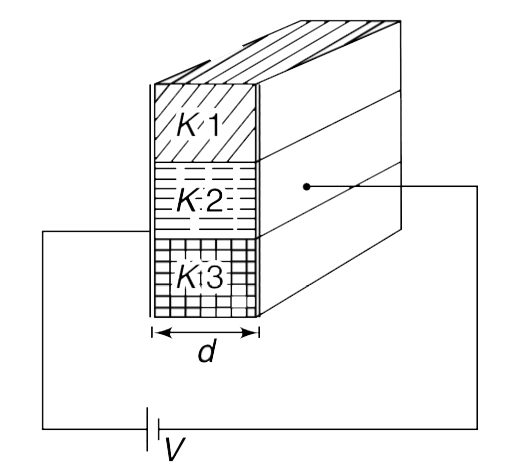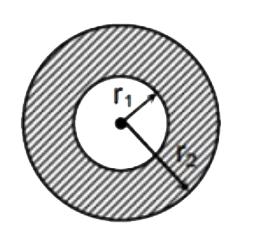Show that the magnitude of the polarisation of dielectric medium is equal to the surface density of bound charges induced on its surface?
Let A be the area of cross section of dielectric slab and its thickness be d. Assume ±σp to be the induced surface charge densities at the front faces of dielectric slab. Equal and opposite charges appears on the front faces of dielectric slab, given by Q=σpA. Electric dipole moment is charge multiplied with distance between the charges. Hence, the electric dipole moment developed can be written as σpAd. Polarisation is electric dipole moment developed per unit volume. Hence, polarisation of dielectric medium is equal to the surface charge density of bound charges induced on its surface. P=σpAdAd=σp.
Topper's Solved these Questions
- ELECTROSTATIC POTENTIAL AND CAPACITANCE BOOK - MODERN PUBLICATIONCHAPTER - ELECTROSTATIC POTENTIAL AND CAPACITANCE EXERCISE - Tough & Tricky PROBLEMS
10 Videos
- ELECTROSTATIC POTENTIAL AND CAPACITANCE BOOK - MODERN PUBLICATIONCHAPTER - ELECTROSTATIC POTENTIAL AND CAPACITANCE EXERCISE - NCERT FILE Solved (Textbook Exercise)
11 Videos
- ELECTROSTATIC POTENTIAL AND CAPACITANCE BOOK - MODERN PUBLICATIONCHAPTER - ELECTROSTATIC POTENTIAL AND CAPACITANCE EXERCISE - PRACTICE PROBLEMS 5
18 Videos
- ELECTROMAGNETIC WAVESBOOK - MODERN PUBLICATIONCHAPTER - ELECTROMAGNETIC WAVESEXERCISE - CHAPTER PRACTICE TEST
14 Videos
- MAGNETISM AND MATTERBOOK - MODERN PUBLICATIONCHAPTER - MAGNETISM AND MATTEREXERCISE - CHAPTER PRACTICE TEST FOR BOARD EXAMINATION
16 Videos
Similar Questions
A point charge q is located in vacumm at a distance l from the plane surface of a unifrom isotropic deilectric filling up all the half-space. The permittivity of the dielectric equals ε. Find :
(a) the surface density of the bound chagres as a function of distanc e r from the point charges q'. anayse the obtained result at l−.0,
(b) the total bound charge on the surface of the dielectric
View SolutionA parallel plate capacitor of plate area A and spac- ing between the plates d is filled with three dielectrics as shown in the Figure. The dielectric constants of the three dielectrics are K1=K,K2=2K,K3=3K. The capacitor is connected to a cell of emf V.
(a) Write the ratio of maximum to minimum charge density on the surface of the capacitor plate.
(b) Calculate the surface charge density of bound (induced) charge on the middle dielectric.
(c) If the three dielectrics occupy equal volume between the plates, calculate the capacitance of the capacitor.

View Solution
Knowledge Check
In the question number 78, the surface charge density on the outer surface is
A−q4πR21Bq4πR22Cq24πR21D2q4πR22In the question number 78, the surface charge density on the outer surface is
A−q4πR21Bq4πR22Cq24πR21D2q4πR22A spherical charged conductor has σ as the surface density of charge. The electric field on its surface is E. If the radius of the sphere is doubled keeping the surface density of charge unchanged, what will be the electric field on the surface of the new sphere -
AE4BE2CED2E
The magnitude of the electric field on the surface of a sphere of radius r having a uniform surface charge density σ is
View SolutionShow that the electric field at the surface of a charged conductor is proportional to the surface charge density.
View SolutionA capacitor having a capacitance of 100μf is changed to a potential difference of 50V.(a) What is the magnitude of the charge on each plate? (b)The charging battery is disconnected and a dielectric of dielectric constant 2.5 is inserted . Calculate the new potential difference between the plate .(c) What charge would have produced this potential difference in absence of the dielectric slab.(d) Find the charge induced at a surface of the dielectric slab.
View SolutionIn the given diagram, there is a conducting sphere of radius r which is surrounded by a dielectric of relative permittivity εr. If conducting sphere is given charge q, then surface density of polarization charges, on the outer surface of the dielectric layer, is

View SolutionThe amount of induced surface charge per unit area of the surface is
View Solution
